Whether it is app development or web development, if you want the product to be successful, you need flow-less code. And code review is what makes it possible.
Now, you can be an investor overlooking your project and ensuring everything is top-notch or a budding developer, in either case, this is for you.
Here, we shall be discussing all you need to know about code review and more importantly, code review best practices.
Therefore, with this being said, let’s get right into it:
What is Code Review?
Code review is an essential process in software development where fellow developers assess and evaluate the code written by their peers.
The purpose of this review is to ensure the quality, efficiency, and maintainability of the code before it is integrated into the main codebase or deployed to production.
By reviewing code, developers can catch errors, identify potential improvements, and promote best practices, ultimately leading to a more robust and reliable software product.
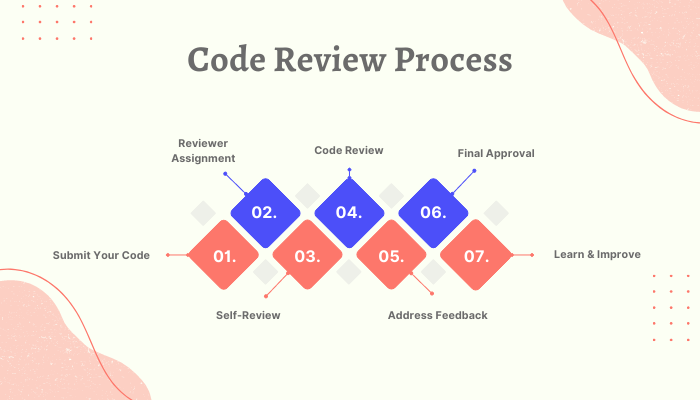
Now, before you get any further, let’s have a glance at the code review process.
- Submit Your Code: After completing your code, submit it for review.
- Reviewer Assignment: A team lead or designated person assigns reviewers with relevant expertise.
- Self-Review: Before the review, self-review your code and prepare a list of specific areas for feedback.
- Code Review: Reviewers examine your code for errors, standards adherence, and improvements.
- Address Feedback: Make necessary changes based on reviewer comments professionally.
- Iterate (If Needed): If substantial changes are required, repeat the review process.
- Final Approval: Once reviewers are satisfied, your code can be merged into the main codebase.
- Learn & Improve: Reflect on feedback to enhance your coding skills for future contributions.
And now that we are done with this, let’s look at the importance of code review before we get into code review best practices.
Why is Code Review Important?
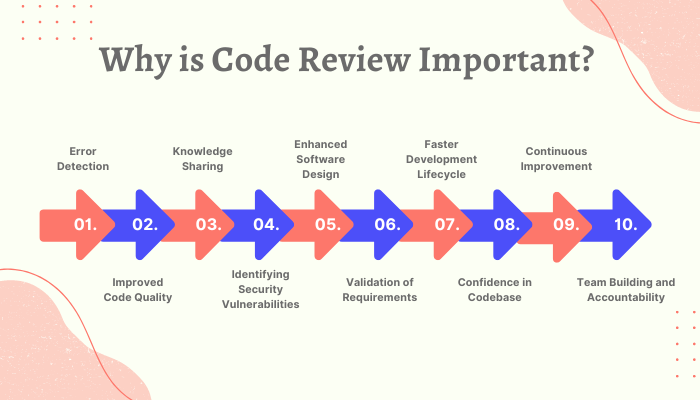
Before you put your dedicated developers to code review and testing, it is a good idea to know why it is important.
Therefore, let’s get right into it:
1. Error Detection
Code reviews help catch errors and bugs that might have been overlooked during initial development. Reviewers can identify issues that you might have missed, leading to more robust and reliable code.
2. Improved Code Quality
Feedback from code reviews encourages you to write better code. It promotes adherence to coding standards and best practices, resulting in cleaner, more maintainable code
3. Knowledge Sharing
Through code reviews, you get exposed to different approaches and techniques used by your peers. This sharing of knowledge fosters a collaborative environment and helps everyone learn from one another.
4. Identifying Security Vulnerabilities
Code review is a crucial step in ensuring the security of the software. Reviewers can spot potential security risks and suggest ways to mitigate them, reducing the chances of security breaches.
5. Enhanced Software Design
Reviewers can provide insights into improving the overall software design. Their valuable feedback can lead to more efficient algorithms and better architectural decisions.
6. Validation of Requirements
Code reviews ensure that your code aligns with the project’s requirements and goals. This reduces the chances of delivering software that does not meet the client’s expectations.
7. Faster Development Lifecycle
Though it might seem like an additional step in the development lifecycle, code reviews often result in faster development in the long run. Early detection and resolution of issues prevent bugs from propagating into later stages, saving time and effort.
8. Confidence in Codebase
Regular code reviews instill confidence in the codebase. Knowing that your code has been thoroughly reviewed by peers reduces anxiety about potential defects.
9. Continuous Improvement
Embracing feedback and learning from code reviews help developers grow. You can identify areas of improvement and work towards becoming a more skilled and proficient coder.
10. Team Building and Accountability
Code reviews foster a sense of accountability within the team. Everyone is responsible for the quality of the code they produce, and reviews create an atmosphere of collective ownership.
Code review is vital because it leads to fewer defects, better code quality, and improved collaboration within the team.
Embrace the process as an opportunity to learn and grow, both as an individual and as part of a skilled development team.
Code Review Best Practices
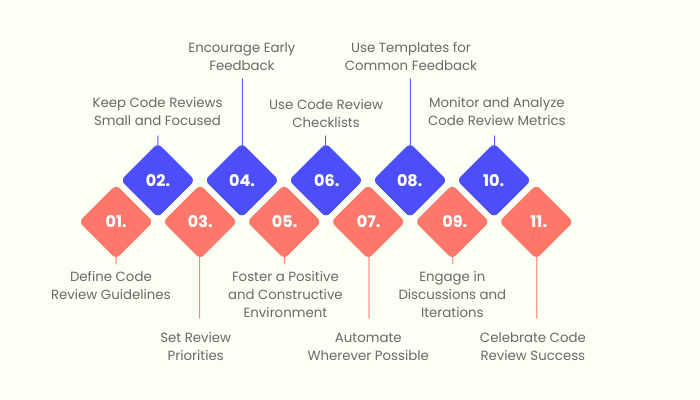
Code review is a crucial aspect of the software development process that helps ensure the quality, reliability, and maintainability of the codebase.
Therefore, in this section of the blog, we’ll walk you through the best practices for conducting code reviews, helping you establish a successful code review process within your development team.
1. Define Code Review Guidelines
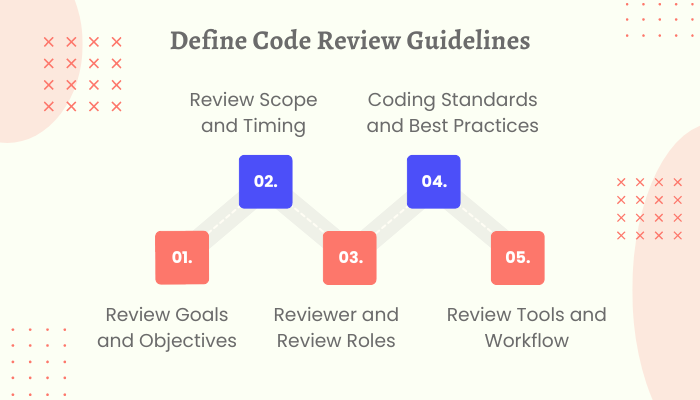
To kickstart your code review process, the first step is to establish clear and comprehensive code review guidelines. ( This is in fact one of the most important code review best practices).
In any case, these guidelines act as a roadmap for the code review process, ensuring consistency across all reviews.
Your guidelines should cover:
a. Review Goals and Objectives
Clearly define the primary goals and objectives of code reviews.
These may include finding bugs, ensuring adherence to coding standards, improving code quality, sharing knowledge, and promoting collaboration among team members.
b. Review Scope and Timing
Specify what should be covered in a code review. This might include all new code, significant changes, and critical bug fixes.
In addition, set expectations regarding the time frame for completing code reviews to avoid bottlenecks in the development process.
c. Reviewer and Reviewee Roles
Clarify the roles and responsibilities of both the reviewer and the reviewee.
The reviewer is responsible for evaluating the code, while the reviewee should be open to feedback and willing to make improvements based on the feedback received.
d. Coding Standards and Best Practices
Document your team’s coding standards and best practices, covering aspects like code formatting, naming conventions, error handling, and security considerations.
Consistent adherence to coding standards ensures a unified codebase and eases the process of maintenance and collaboration.
e. Review Tools and Workflow
Specify the tools and platforms that will be used for conducting code reviews.
Popular code review tools include GitHub Pull Requests, GitLab Merge Requests, and Phabricator.
Moreover, ensure everyone on the team is familiar with the chosen tool and the workflow for creating, reviewing, and merging code changes.
2. Keep Code Reviews Small and Focused
Another one of the important code review best practices is, keeping it small and focused.
You should be breaking down code changes into smaller, manageable chunks is a key best practice. Smaller changes are easier to review, and they minimize the risk of introducing multiple issues into the codebase.
As a general rule, aim to keep each code review focused on a single task or user story.
3. Set Review Priorities
Not all code changes are created equal.
Therefore, one of the best practices for code review, prioritize code reviews based on their impact and urgency. Critical bug fixes and security updates should take precedence over other changes.
By setting priorities, you ensure that important issues are addressed promptly, improving the overall code quality.
4. Encourage Early Feedback
Promote a culture of early feedback within the development team.
Encourage developers to seek informal feedback from peers before submitting code for a formal review.
Early feedback helps catch issues at an early stage, reducing the cost of fixing problems later in the development process.
5. Foster a Positive and Constructive Environment
Creating a positive and constructive environment for code reviews is essential to ensure that they are effective and well-received.
Encourage reviewers to provide feedback in a respectful and supportive manner, focusing on the code rather than the person who wrote it.
Emphasize the importance of teamwork and shared responsibility in creating a high-quality codebase.
6. Use Code Review Checklists
Code review checklists are powerful tools that assist reviewers in systematically evaluating code changes.
These checklists can be tailored to your team’s specific needs and coding standards. They help ensure that no critical aspects are overlooked during the review process. Examples of checklist items may include:
a. Code Readability and Maintainability
– Are variable names descriptive and follow the established naming conventions?
– Is the code properly indented and formatted according to the coding standards?
– Are comments clear, informative, and up-to-date?
b. Code Logic and Functionality
– Does the code correctly implement the desired functionality?
– Are there any edge cases that have not been handled properly?
– Are the algorithms and data structures used appropriately for the task?
c. Error Handling and Exception Management
– Are error messages clear and user-friendly?
– Are exceptions handled appropriately, and are there any potential memory leaks?
d. Security Vulnerabilities
– Are there any potential security vulnerabilities, such as SQL injection or Cross-Site Scripting (XSS) vulnerabilities?
– Are sensitive data appropriately handled and protected?
e. Testing and Test Coverage
– Has the code been adequately tested, and are there unit tests for new functionality?
– Is the test coverage sufficient for the code changes?
This is one of the code review best practices that will take you a long way if done right.
7. Automate Wherever Possible
Leverage automation tools to streamline the code review process and ensure consistency.
Code linters can automatically check for coding standard violations, while continuous integration pipelines can run automated tests on the code changes.
Moreover, integrating these tools into your workflow reduces the burden on reviewers and ensures that no critical issues slip through the cracks.
8. Use Templates for Common Feedback
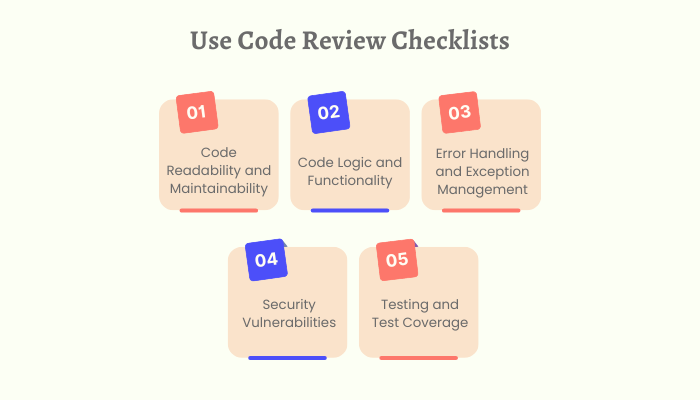
To save time and provide consistent feedback, create templates for common review comments.
These templates can be used as a starting point for reviewers to customize their feedback to suit the specific code change.
However, encourage reviewers to personalize their comments where necessary to address unique aspects of the code.
9. Engage in Discussions and Iterations
Code reviews should not be a one-way street.
Encourage the reviewer to engage in discussions with the reviewer and other team members. If a reviewer provides feedback that the reviewer disagrees with, they should be encouraged to respectfully discuss their perspectives.
Code review is often an iterative process, with multiple rounds of feedback and improvements, leading to a better final result.
10. Monitor and Analyze Code Review Metrics
Keep track of code review metrics to identify trends and areas for improvement.
Metrics like review turnaround time, review comments per reviewer, and defect density can provide valuable insights into the effectiveness of your code review process.
Use these metrics to make data-driven decisions to optimize your code review workflow continually.
12. Celebrate Code Review Success
Recognize and celebrate successful code reviews that result in significant improvements to the codebase.
Publicly acknowledge the efforts of both reviewers and reviewees to foster a positive code review culture within the team.
And with this, we are done with the code review best practices, we are done.
Conclusion
So, these are the code review best practices that you need to know of. Now, if you are having difficulties writing code, it’s highly recommended that you consult software developers who will be able to help you with the same.
FAQs
Conduct code reviews after completing a significant portion of code or before merging changes into the main codebase.
Ideally, all team members can participate as reviewers, including senior developers, peers, and even stakeholders.
Follow a structured process, provide constructive feedback, and focus on code readability, security, efficiency, and adherence to guidelines.
Yes, using automated tools can help catch basic issues like style violations, but human reviews are still essential for complex logic and design aspects.
A good code reviewer is knowledgeable, respectful, objective, and has excellent communication skills to provide clear feedback.
Encourage open discussions, avoid personal attacks, and base decisions on the best interest of the project.
Treat it as a high priority, fix it immediately, and consider a post-mortem to prevent similar issues in the future.
The duration varies based on the complexity of the changes, but try to complete reviews within a few days to maintain a smooth development process.
Provide mentoring and additional training if needed, but also ensure that feedback is constructive and helps the developer improve.
Foster a positive and supportive team culture, recognize good reviews, and consider occasional fun activities to promote engagement.
Yes, documenting feedback helps track improvements, provides reference points, and facilitates knowledge sharing across the team.

Niketan Sharma is the CTO of Nimble AppGenie, a prominent website and mobile app development company in the USA that is delivering excellence with a commitment to boosting business growth & maximizing customer satisfaction. He is a highly motivated individual who helps SMEs and startups grow in this dynamic market with the latest technology and innovation.
Table of Contents












No Comments
Comments are closed.